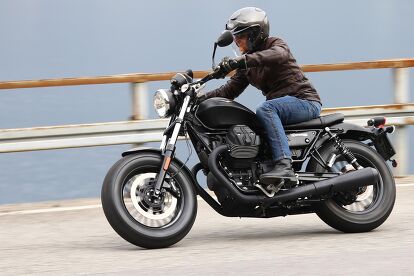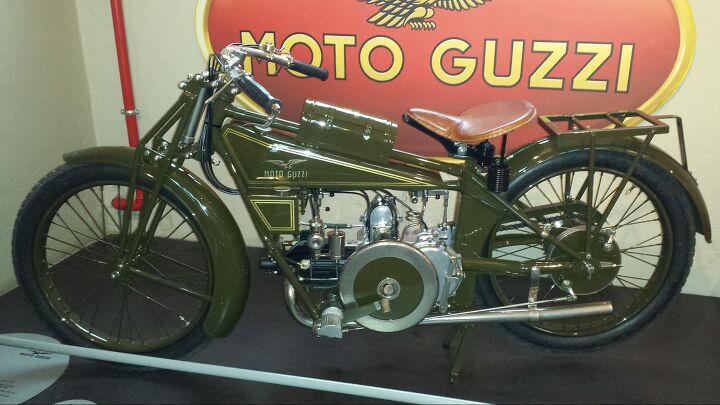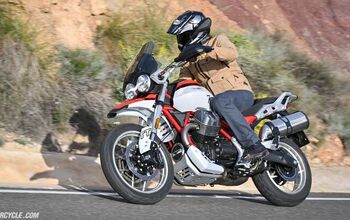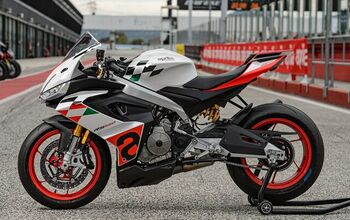Duke's Den – Inside Moto Guzzi
My first Guzzi press intro
Writing about motorcycles for a quarter century has given me incredible opportunities on and around bikes of all sorts, many of which are the kinds of behind-the-velvet-rope things available only to motojournalists. I feel truly blessed when I look back at the breadth of experiences bestowed upon me just because I can fumble out a few words describing them.
Having ready access to the latest motorbikes is surely the most obvious benefit of carrying the motojourno card – I’ve passed the 700 mark of press bikes I’ve ridden, and I’ve appreciated the experience of each, all different in both large and subtle ways. But the jewel of the job is receiving an invitation to a bike launch. They were informally known as press intros/introductions before the tool of printing presses suddenly transformed into something as seemingly archaic as a typewriter. Similarly, the OEMs formerly supplied bikes from their “press” fleets. And had carbon-paper contracts and fax machines…
Anyway, before I reach further in my past and tell you what is was like to walk with dinosaurs, let me get back to media introductions, the wonderful parties manufacturers host in scenic locations hand-picked as highly desirable places in which to test a fabulous new motorcycle that no one outside factory employees has yet ridden. Oh, and you can usually count on a nice slice of beef and a glass of wine to wash it down, plus a pleasant room most often with sheets of a higher thread count than the ones you have at home.
I’ve probably been to nearly 100 of these events over the years, but I had yet been to a Moto Guzzi press…, er, media launch. Guzzi has, like every Italian motorcycle manufacturer, had eras in which resources for product development have been scarce, so the historic Italian marque’s lineup hasn’t exactly been busting at the seams in the past several decades. Less product equals less bike launches, and Guzzi wasn’t offering much support to online magazines like MO anyway.
But Guzzi’s eagle was brought under the wing of the Piaggio Group in 2004, adding some much-need financial stability to the brand around the same time a $45 million restoration of the Guzzi factory near the shores of Lake Como in northern Italy was completed. Aprilia, the former owner of Guzzi, also became part of Piaggio, and it received the bulk of R&D resources while Guzzi waited for its turn.
Guzzi sales began ramping up in earnest with the 2008 introduction of the retro-inspired V7 Classic. The V7 remains Guzzi’s stalwart, with sales up 44% in 2015 after a fairly extensive revamp that added the II suffix to its name. The V7 II now makes up more than 60% of the brand’s sales. The V7 is a retro-cool machine, but its lovely-looking motor won’t ever be called a powerhouse.
2016 Moto Guzzi V7 II Stone Review
Then in 2013 a new cruiser exited the gate at the Guzzi factory, a fresh California boasting an all-new 1380cc V-Twin engine. Although the Cali is no real threat to the other iconic cruiser brand with an eagle association, Harley-Davidson, the California has become Guzzi’s number-two platform. Its sales are up 36% in 2015 after the recent introductions of the Audace and Eldorado variants. This summer we’ll see the MGX-21, an audacious bat-winged bagger that just might steal some bar-and-shield customers.
The Eldorado and Audace launches were held near Mandello del Lario, the birthplace of all Guzzis since 1921, and I had a bit of remorse when I passed along the invite to our cruiser expert, Evans Brasfield, as it’s not often that journalists get invited to historic old factories near George Clooney’s summer home. Happily, I was given a second chance when Guzzi tossed out the invite to the launch of the new V9 series consisting of Bobber and Roamer variants.
And so there I was in Mandello at the historic factory that was born in the years following World War I when three members of the Italian air force (Carlo Guzzi, mechanic Giovanni Ravelli and pilot/racer Giorgio Parodi) joined forces. I walked within the history-steeped walls almost exactly 95 years after the company pushed out its first motorcycle, and this alone was enough to make my visit special.
What stood out as a journalist was Guzzi’s presentation being completely in Italian; a headset with translation was necessary for me to understand words that weren’t grazie and pizza. Meanwhile, down the road in Bologna, Ducati makes all its presentations in English.
“We are deeply Italian,” said Davide Zanolini, head of Guzzi’s marketing and communication, during the presentation. “Not German, not American, not Chinese… We’re Italian.”
The full story of the V9 can be found in the link below, but here’s the short one. This is the newest “small-block” Guzzi V-Twin, stretching the V7’s 744cc to 853cc. The switch from the V7’s old-school Heron head to a more modern hemispherical combustion chamber is the biggest change, and it opens up tuning options for more power. Guzzi claims 90% of the engine parts are new.
2016 Moto Guzzi V9 Bobber And V9 Roamer First Ride Review
Rather than a bigger V7 retro roadster, the Italians are angling the pair of V9s as pseudo cruisers. Both models are likeable in many ways, but they are slightly handicapped in performance terms by their cruiser-oriented front tires: the Bobber uses a fat 16-incher, while the Roamer uses a skinny 19-inch hoop. For my tastes in motorcycles, I’d be especially interested in a V9 with a sportier intent. Not super-sporty, just something a little closer to a retro/traditional roadster. A Moto Guzzi Bonneville R of sorts.
I’d call it the V9 Sport, and the main modification I’d make would be to simply bolt on a pair of lightweight wheels that could fit some reasonably grippy radial tires: maybe an 18/17-inch combo instead of a pair of ubiquitous 17s. I could imagine about 15% more power with a set of lumpier cams, a lighter flywheel and a freer-flowing, higher-mounted exhaust system. Fit a radial-mount Brembo monoblock brake caliper to slow it down. Ergonomically, I’d push the footpegs back a bit for additional cornering clearance and fit a tapered aluminum handlebar just a skosh lower than the Bobber’s. A three-way adjustable suspension would supply finer control whether circumnavigating Lake Como or Yosemite. If this could be accomplished for a $1,500 premium over the Roamer, I’d call it highly desirable and a relative bargain at $11.5k.
And this was one of the topics I brought up with a couple of Guzzi reps after our ride on the V9s. Engineers and media-relations folks are loathe to reveal any plans for future product, and of course, that was the case here, too, despite conversing over a tasty dinner and a couple bottles of wine. But I learned through our multifarious conversation that these Piaggio Group employees are major-league moto enthusiasts, and I could sense excitement behind their eyes when talking about anything involving high-performance motorcycles. The concept of a V9 Sport was appreciated if not admitted.
So, do I have evidence we’ll see a V9 Sport? No, none whatsoever. However, I’ve been around the block a time or two and have a fairly good understanding of which kinds of motorcycles sell and the relative costs of developing them. I believe a V9 Sport would appeal to a different audience that the one which likes the tame V7 or the cruiserish V9s, and it could be brought to life without significant investment in R&D efforts. Heck, I’d give it whirl if they’d let me!
“Piaggio is investing massively in (Moto Guzzi),” said Leo Mercanti, head of two-wheel product marketing for the Piaggio Group, during the V9’s presentation. Unfortunately, I didn’t sit with him over chianti to find out what he thought of my V9 Sport idea.
More by Kevin Duke









































Comments
Join the conversation
I thoroughly enjoyed reading your behinds the scenes article “Inside Moto Guzzi”. I especially liked your comment that the presentation was in Italian, and that the marketing director was indeed a very proud Italian. Moto Guzzi has always been a fiercely proud marque that insists on doing things their way, and not following the Germans, Americans or the Chinese (or the British decades ago). It’s a testament to that proud heritage that Moto Guzzi has survived all these years.
I was born and bred in a small university town in California where the bike of choice wore a British nameplate of the side of the tank (I cut my teeth on a BSA B40, then a BSA B44VS). This was the early sixty’s, before the Japanese motorcycle invasion was in full swing. Because this was a university town, with students and professors from around the world, I would occasionally spy unusual and intriguing bikes from other manufacturers. One such bike was the Moto Guzzi V7 Sport that I saw in the early seventy’s. I was fascinated by the sight of those two big jugs sticking out the sides, and that beautiful Italian styling. I recall thinking I would like to own one of those bikes someday. The years passed, then the decades passed, and it was time to finally retire and spend my golden years enjoying motorcycling seven days a week. I bought a 2015 Triumph Scrambler and really enjoy the retro-look without all the oil leaks and questionable reliability of those original British bikes (do you remember Lucas the prince of darkness). I also bought a 2015 Scrambler Ducati because of that sweet desmo motor and that Italian design that merges form with function. It is such a sweet bike to ride; I threw a duffle bag across the seat and took a 10 day ride to the Colorado Rockies. (That Ducati loved those twisty mountain roads, especially Hiway 82 south out of Aspen.) One would think that owning two new motorcycles would be plenty, but I had room in my garage for another. So, I did my usual research of the available bikes, and decided it was indeed time for 2015 Moto Guzzi V7 Special. I knew it was down on power, and it still used old technology (push rods, really?) but I wanted a true Moto Guzzi built in that same old-world factory where they began. What a colossal mistake that was. Apparently the fierce pride held by upper management is not held by the employees who actually assembly the bikes. My new Moto Guzzi was delivered to me with numerous defects in workmanship, seemingly no quality control of any kind except for a lot of yellow paint on every nut and bolt, and absolutely no customer care. Let me repeat that, NO customer care.
Maybe it’s time for Moto Guzzi to break from tradition and follow the lead of the other manufacturers and begin assembling their bikes in Thailand. My Triumph, my Ducati, and my 2011 KLR 650 were all assembled in Thailand with NO defects in workmanship at all.
I will never purchase another Moto Guzzi, and would recommend others stay away as well.
Ah, Guzzi my love. I can't but be grateful for Piaggio putting their money up and keeping the great marque still flying. OK, their business sense seems to be making the bikes a little more anodyne, but at least the great big Vee twins are still out there, fighting against emissions and noise requirements. Everyone should have a Guzzi - I've got four and have had over twenty. they're beautiful, soulful things. Maybe this summer I'll ride the Como road and listen to the exhaust beats bounce off the cliffs, take the bike up over the passes into Switzerland and round the hairpins back into Italy. I won't buy a V9, because my le Mans and 750 take up all my time, but if you want a new bike, you should. Fall in love, Stay in love. Buy a Guzzi.